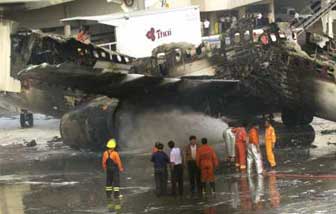Thai Explosion Leads To U.S. Rule On 737 Fuel Pump Procedures
By Sean Broderick
25-Apr-2001 3:07 PM U.S. EDT

U.S. regulators Wednesday ordered 737 operators to follow Boeing recommendations that say center fuel tank pumps should not be switched on for long periods of time if no fuel is running through them, since vapors could be ignited by metal-to-metal contact of pump parts, possibly triggering a catastrophic fuel tank explosion.
The Federal Aviation Administration (FAA) immediate-adoptive airworthiness directive (AD), triggered by two 737 fuel tank explosions that may have been caused by "dry" running of the center tank pumps, orders U.S. operators to modify their 737 flight manuals by May 17. Inserting a copy of the AD qualifies as compliance.
"For ground operation, center tank fuel pump switches must not be positioned to 'ON' unless the center tank fuel quantity exceeds 1,000 pounds (453 kilograms), except when defueling or transferring fuel," the directive says. "Center tank fuel pump switches must be positioned to "OFF" when both center tank fuel pump low pressure lights illuminate. Center tank fuel pumps must not be "ON'' unless personnel are available in the flight deck to monitor low pressure lights.''
FAA's rule comes less than two months after a Thai Airways 737-400 (pictured) exploded while sitting at a bay at the Don Muang International Airport, Bangkok, Thailand. The cause of the accident hasn't been determined, but investigators know the plane's center tank exploded. They also know that the center tank pumps were running dry before the explosion, as were heat-generating air conditioning packs located under the near-empty, vapor-filled center tank. No traces of explosives have been found in the wreckage.
The Thai accident was similar to a 1990 center tank explosion on a
Philippine 737-300. The ignition source of that explosion was never
identified.

"Extended dry operation of the center tank fuel pumps, which had occurred prior to both incidents, is contrary to the manufacturer's procedures for safe operation of the fuel pumps," FAA said in Wednesday's rule. It can lead to "overheating and excessive wear of the pump bearings and consequent contact between rotating and non-rotating parts of the pumps," both of which can create "hot surfaces or sparks" that could ignite fuel vapors in pumps, which then can travel into tanks and trigger an explosion.
Boeing's 737 procedures have always said that center tank pumps should be switched off when the cockpit-mounted low-pressure lights come on. The manufacturer also advises operators to use ground power in lieu of air conditioning packs on parked aircraft.
Earlier this month, based on information learned from the Thai accident, Boeing sent a message to 737 operators underscoring the recommended center tank pump procedures, and clarifying several items that some carriers felt were ambiguous. For instance, Boeing specified that a 737 center tank should have at least 1,000 pounds of fuel in it before its pumps are turned on. Before, no amount was specified.
Most U.S. operators have long understood the significance of these Boeing-recommended procedures and already abide by them, safety officials and airline sources say. But the Thai and Philippine incidents show that some carriers in other parts of the world do not.
Regulators tend to follow the lead of a manufacturer's home agency when it comes to turning advisories into rules. By mandating the fuel pump recommendations, FAA has brought closer attention to them than Boeing could, since manufacturers are powerless to mandate service advisories.